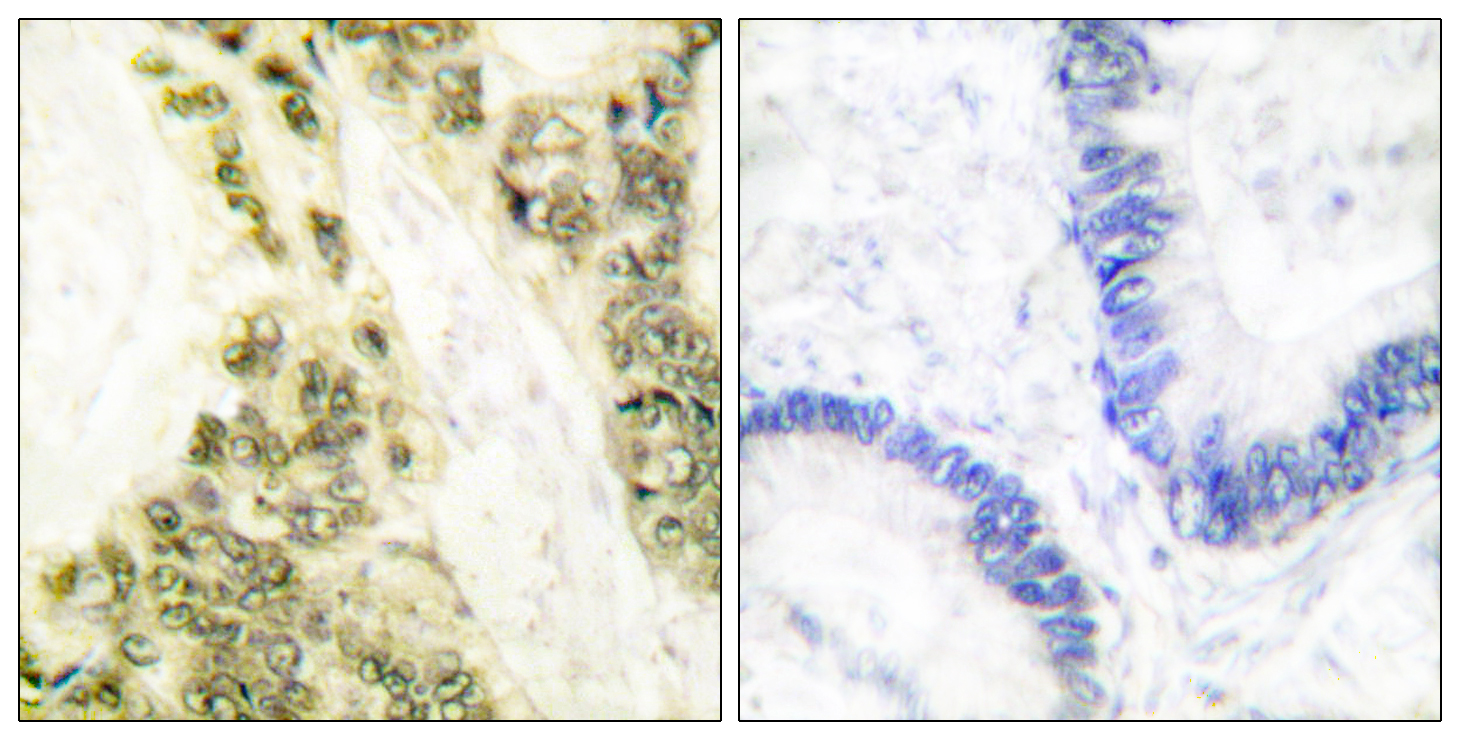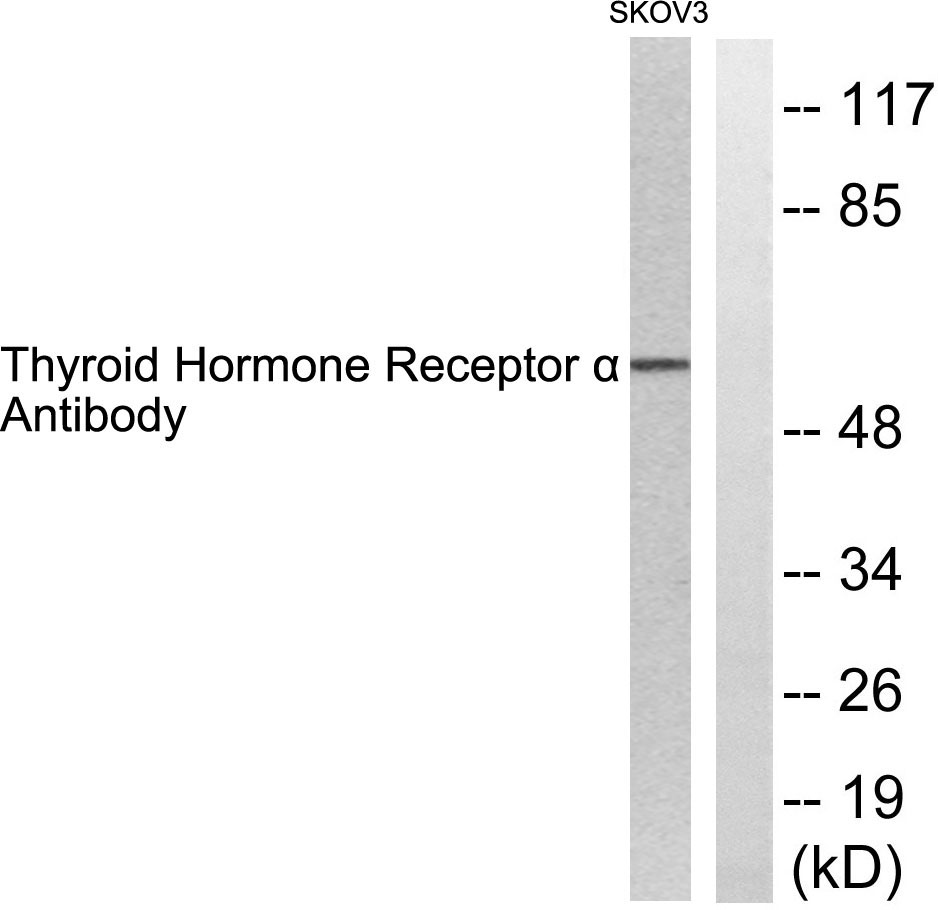TRα Polyclonal Antibody
- Catalog No.:YT4755
- Applications:WB;IHC;IF;ELISA
- Reactivity:Human;Mouse;Rat
- Target:
- TRα
- Fields:
- >>Neuroactive ligand-receptor interaction;>>Thyroid hormone signaling pathway
- Gene Name:
- THRA
- Protein Name:
- Thyroid hormone receptor alpha
- Human Gene Id:
- 7067
- Human Swiss Prot No:
- P10827
- Mouse Gene Id:
- 21833
- Mouse Swiss Prot No:
- P63058
- Rat Gene Id:
- 81812
- Rat Swiss Prot No:
- P63059
- Immunogen:
- The antiserum was produced against synthesized peptide derived from human Thyroid Hormone Receptor alpha. AA range:10-59
- Specificity:
- TRα Polyclonal Antibody detects endogenous levels of TRα protein.
- Formulation:
- Liquid in PBS containing 50% glycerol, 0.5% BSA and 0.02% sodium azide.
- Source:
- Polyclonal, Rabbit,IgG
- Dilution:
- WB 1:500 - 1:2000. IHC 1:100 - 1:300. ELISA: 1:10000.. IF 1:50-200
- Purification:
- The antibody was affinity-purified from rabbit antiserum by affinity-chromatography using epitope-specific immunogen.
- Concentration:
- 1 mg/ml
- Storage Stability:
- -15°C to -25°C/1 year(Do not lower than -25°C)
- Other Name:
- THRA;EAR7;ERBA1;NR1A1;THRA1;THRA2;Thyroid hormone receptor alpha;Nuclear receptor subfamily 1 group A member 1;V-erbA-related protein 7;EAR-7;c-erbA-1;c-erbA-alpha
- Observed Band(KD):
- 55kD
- Background:
- The protein encoded by this gene is a nuclear hormone receptor for triiodothyronine. It is one of the several receptors for thyroid hormone, and has been shown to mediate the biological activities of thyroid hormone. Knockout studies in mice suggest that the different receptors, while having certain extent of redundancy, may mediate different functions of thyroid hormone. Alternatively spliced transcript variants encoding distinct isoforms have been reported. [provided by RefSeq, Jul 2008],
- Function:
- domain:Composed of three domains: a modulating N-terminal domain, a DNA-binding domain and a C-terminal steroid-binding domain.,function:Nuclear hormone receptor. High affinity receptor for triiodothyronine.,similarity:Belongs to the nuclear hormone receptor family.,similarity:Belongs to the nuclear hormone receptor family. NR1 subfamily.,similarity:Contains 1 nuclear receptor DNA-binding domain.,subunit:Interacts with NCOA3 and NCOA6 coactivators, leading to a strong increase of transcription of target genes. Probably interacts with SFPQ. Interacts with C1D (By similarity). Interacts with AKAP13.,
- Subcellular Location:
- Nucleus.; [Isoform Alpha-2]: Cytoplasm . Nucleus . When overexpressed found in the cytoplasm where it colocalizes with TACC1. .
- Expression:
- Brain,Brain cortex,Hippocampus,Kidney,Muscle,Testis,
- June 19-2018
- WESTERN IMMUNOBLOTTING PROTOCOL
- June 19-2018
- IMMUNOHISTOCHEMISTRY-PARAFFIN PROTOCOL
- June 19-2018
- IMMUNOFLUORESCENCE PROTOCOL
- September 08-2020
- FLOW-CYTOMEYRT-PROTOCOL
- May 20-2022
- Cell-Based ELISA│解您多样本WB检测之困扰
- July 13-2018
- CELL-BASED-ELISA-PROTOCOL-FOR-ACETYL-PROTEIN
- July 13-2018
- CELL-BASED-ELISA-PROTOCOL-FOR-PHOSPHO-PROTEIN
- July 13-2018
- Antibody-FAQs
- Products Images

- Immunohistochemistry analysis of paraffin-embedded human colon carcinoma tissue, using Thyroid Hormone Receptor alpha Antibody. The picture on the right is blocked with the synthesized peptide.

- Western blot analysis of lysates from SKOV3 cells, using Thyroid Hormone Receptor alpha Antibody. The lane on the right is blocked with the synthesized peptide.


